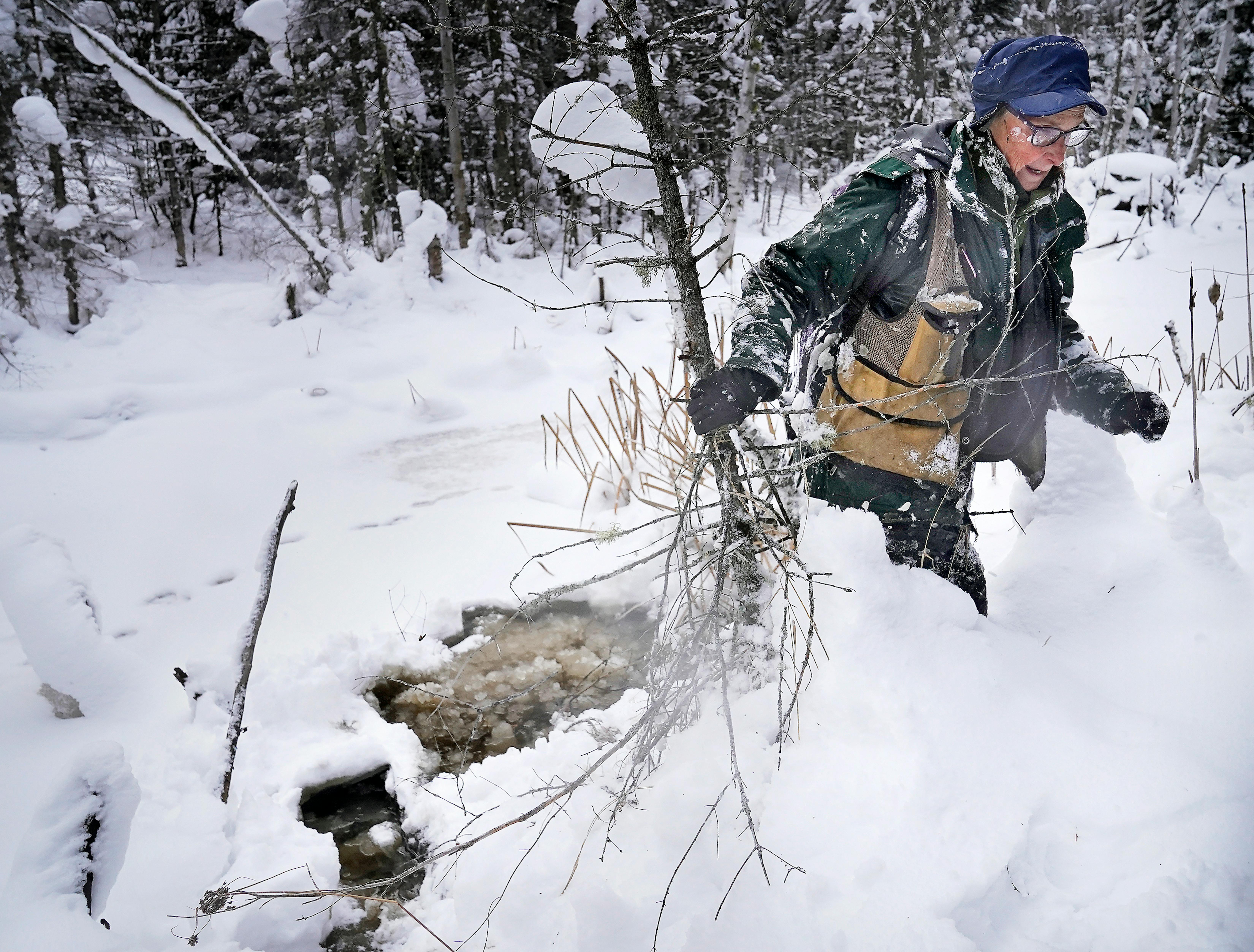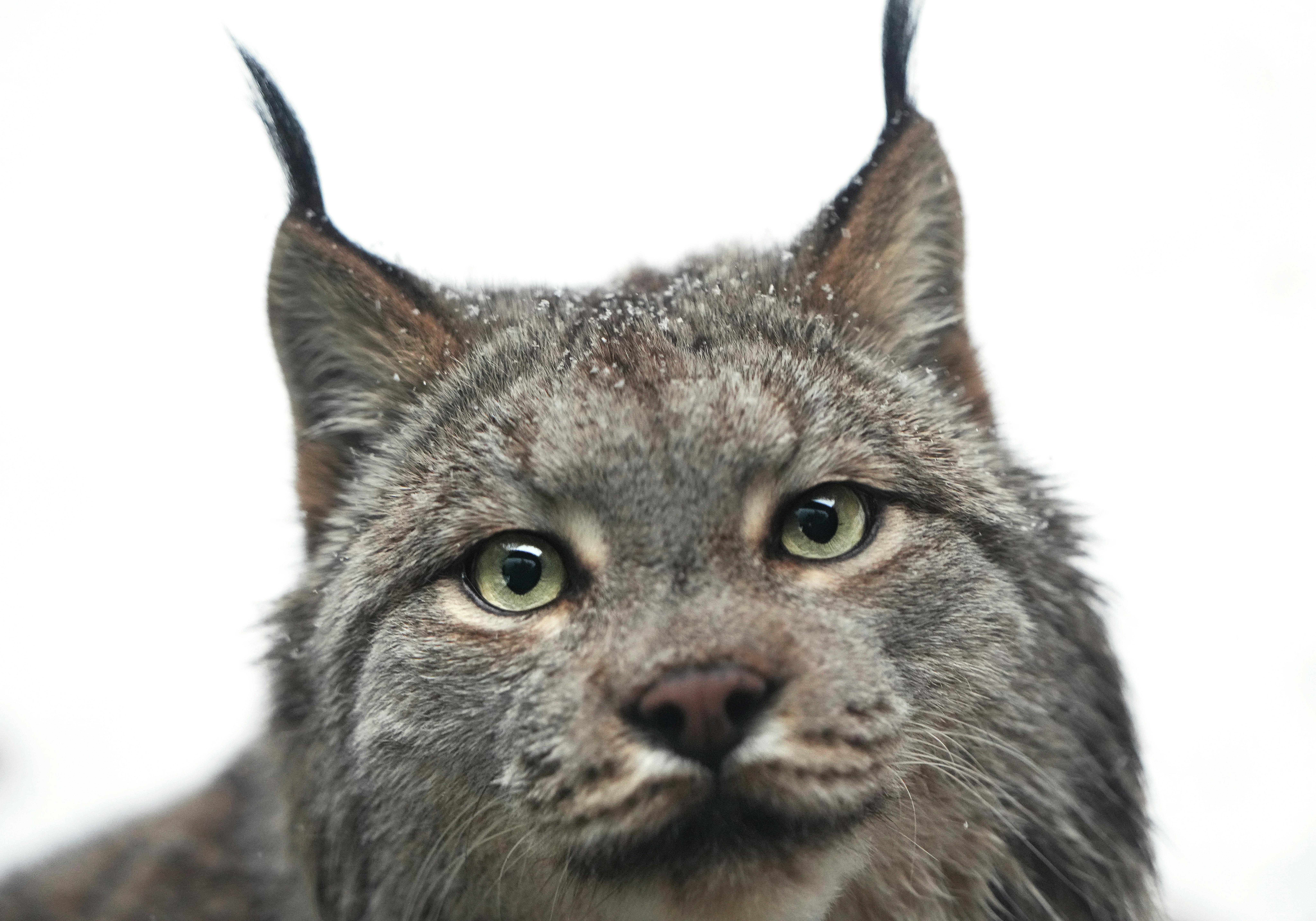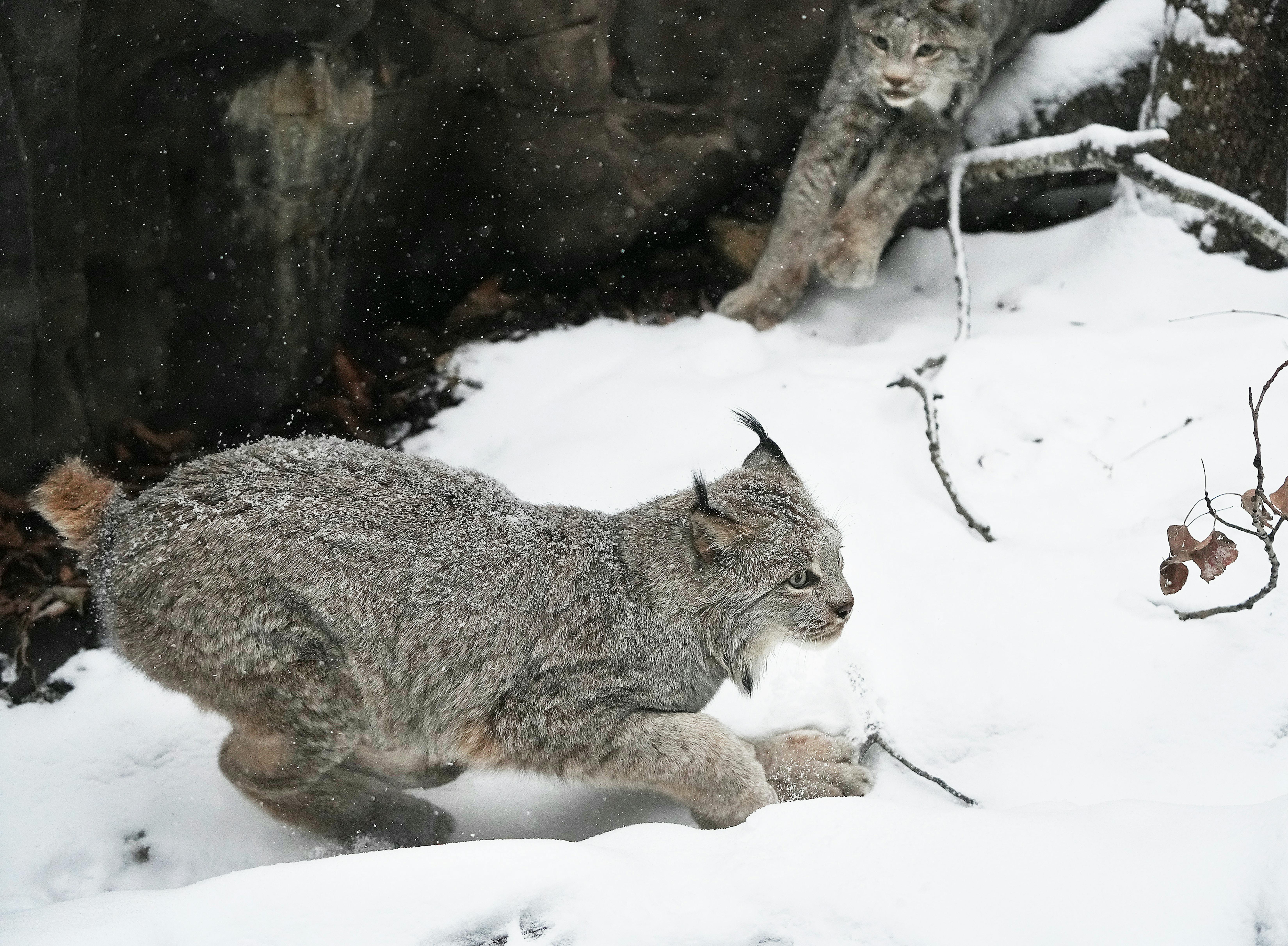Norma Malinowski had been cruising through Superior National Forest since dawn in a muddied white U.S. Forest Service truck, her eyes scanning the snow-covered roads and ditches for round tracks.
Vanishing North
An occasional series in the Star Tribune documenting the biodiversity crisis and the people struggling to head off extinction for Minnesota’s most vulnerable animals and plants.
She pushed on from Ely toward the little community of Finland when a fellow tracker radioed the message she'd been waiting for: "We found a possible family." A family of Minnesota's elusive native cat, the Canada lynx.
Malinowski headed down a remote forest service road where the others were parked. A maze of animal tracks zigzagged into the forest and out again.
Draped in thick snow, the forest was hushed, save for the warbling of a lone pine grosbeak in the treetops — and rapid discussion among Malinowski and U.S. Forest Service wildlife technicians Dylan Welch and Ryan Pennesi about the next step. They donned their snow gear and entered the spruce lowlands.
The lynxing had begun.
No one expected to actually see the cats. Sightings are dumb luck. It's the scat, or feces, the trio was after.
To Malinowski, lynx poop smells good — sweet and not like the stinky wolf stuff, a fragrance she chalks up to the cat's special diet. More importantly, analyzing scat is a key way to monitor an animal that's spread out and exceedingly evasive.
There are any number of other methods for tracking wildlife: flying planes, helicopters and drones around, deploying trail cams, soliciting reports from hunters and setting out foul-smelling synthetic scent lures that look like Alka-Seltzer tablets to attract animals to track recording stations.
But the lynx is the only big animal in Minnesota whose scat has been a mainstay for surveying for so long, said John Erb, a carnivore research scientist with the state Department of Natural Resources. It yields not just information about trends and abundance, but about specific individuals — a twofer, without having to capture and handle the animals.



The surveys and DNA work could hold crucial clues to preventing the lynx from suffering the same fate as mountain lions, which are considered nearly extirpated in Minnesota. The Minnesota population of lynx is estimated to be somewhere between 100 and 300.
Malinowski, 70 and retired from the forest service, is lean and fit, her long hair tied back in a ponytail. She's at an age where most would settle into more conventional hobbies. Her friends cross-country ski, she said. She prefers what she calls lynxing, the solo volunteer work that sends her into the back country. She has a solid retirement income, she said, and wants to give something back.
When the conditions are right — just after a snowfall so lynx have time to make fresh tracks — she rises at dawn, packing snacks, water, batteries, a GPS and a compass. She searches until dark before returning home to Ely, where she lives with her son Riley and their chubby cat Snickers.
For Malinowski, lynxing is a treasure hunt, like geocaching without predetermined coordinates. And she's among the best, said U.S. Forest Service wildlife biologist Dan Ryan, one of the state's top lynx experts.
The years of DNA and survey work will play into efforts underway to produce a species recovery plan to head off extinction for the lynx in the Lower 48. The lynx still doesn't have such a plan, although it's been 22 years since it was listed as threatened under the U.S. Endangered Species Act.
Canada lynx once ranged far enough to leave their scat in about half the states. In Minnesota alone from 1930 to 1976, hunters and trappers in some years killed more than 500, state records show. Development, logging and the fur trade reduced their numbers.
Outside of Alaska, they're now confined largely to eight states, with climate change expected to shrink their numbers further as warmer, shorter winters erode their deep-snow habitat and the boreal forest recedes farther north.
Minnesota banned hunting or trapping lynx in 1984 and listed them as a special concern species in 2013. The few hundred that remain live mostly in Superior National Forest. Though they lend their name to the Minnesota WNBA team, lynx don't loom large in the public imagination like wolves.


Highly specialized predators, the cats dine almost exclusively on the snowshoe hare, which needs a conifer-heavy mix of young and old forest — a messy landscape of upturned root masses of fallen trees, rocks, shrub thickets and log piles. Cottontails don't live this far north.
Lynx don't travel in packs, or howl in groups at night. They don't attack livestock or people. They are rarely seen, although unlike bobcats, they are not fearful. A Star Tribune reporter and photographer made more than seven trips and logged hundreds of miles trying to spot the animal, with no luck.
Minnesota's wet northern forests remain a stronghold in the Lower 48, with a small but generally stable lynx population that is breeding and also moving back and forth between Ontario. Maintaining those corridors to Canada's boreal forest is considered essential to the lynx's survival.
On her lynxing trip in late November, Malinowski parked her truck deep in Superior National Forest near the Sawbill Trail. She pulled on a coat with a duct-taped elbow, and a U.S. Forest Service vest. Fearing she might lose the truck keys, she tucked them inside the fuel door. Then she marked her coordinates on her GPS and turned on a tracker to record her route. She headed in.
It was early winter, and wet where the boggy forest floor and creek hadn't completely frozen. For the uninitiated, bushwhacking in this forest in winter feels like slowly crashing through a plate-glass window. Branches snap at your face as pines dump loads of snow on your head and down your back. It's an obstacle course of downed trees, shrubby undergrowth, boulders and slush.
None of this would hamper a lynx.
With its dense fur, unusually long hind legs that appear to tip it forward, and huge padded paws like snow shoes, the lynx evolved to bound through deep snow to catch snowshoe hares. It is said that the cat's eyesight is so keen it can spy a mouse at 250 feet, a distance longer than an NHL hockey rink.
The lanky cats are often confused with bobcats. Both have bobbed tails, spots and tufts of hair on the tips of their ears and chins that give them a distinguished look. But bobcats are smaller, live farther south and are more timid. Ryan's rule of thumb: if it's a running blur, it's a bobcat. If it sits and looks at you, it's a lynx.
The set of paw prints Malinowski was following looked promising. She moved quickly through the undergrowth to a snowed-over creek. The cat had strolled across the flat white surface and disappeared around a bend.
Malinowski picked through the cattails on the edge in pursuit. Then suddenly the snow gave way beneath her. She slipped into the dark, icy water, so deep she couldn't touch the bottom. Her first thought was to save the cellphone in her pocket. She flipped onto her back and managed to get herself onto the bank.
It was over in seconds, but she was wet to her waist.
"That's a first," she said calmly. No more following those tracks.
Dripping, she returned to the truck, wrung out her gloves and removed her soaked jacket. She told the wildlife technicians Welch and Pennesi that she'd decided to go swimming.
It was around noon, but she did not pause to eat the Italian wrap she bought in a gas station and left in the back seat. She was wearing plenty of layers, and the water surprisingly had not soaked through her snow pants or boots. The cellphone was fine. The scat hunt was more important than lunch.
Donning a dry, mismatched pair of gloves, she set out on foot down the road to follow a different set of prints. She and other lynxers will together hike scores of miles, collecting an average of 148 samples of lynx scat a year, records show.
The poop they collect goes into brown paper lunch bags that will end up at Dan Ryan's office in Aurora, Minn., probably atop a cabinet in the basement since the samples get a bit pungent when they thaw before they dry out, he said. He mails them in batches to the National Genomics Center for Wildlife and Fish Conservation in Missoula, Mont., which runs the DNA tests.

The information is fed into a Superior National Forest Canada lynx genetic database that Ryan's team created, yielding important information about the creature's population, reproduction, families and survivorship. Included are 44 samples from lynx-bobcat hybrids, almost always a male bobcat mating with a female lynx.
The data will help inform the national lynx recovery plan, the goal of years of litigation by conservation groups. The long delay in the lynx recovery plan is not unusual. About one-quarter of the species eligible for a formal recovery plan don't have one, according to a 2018 report in the journal Conservation Letters titled "Missing, Delayed, and Old: The Status of ESA Recovery Plans."
The authors — one of whom is Jacob Malcom, now the director of the Office of Policy Analysis at the U.S. Department of the Interior — blame chronic underfunding of the two agencies in charge of administering the Endangered Species Act and creating recovery plans: the U.S. Fish and Wildlife Service and the National Marine Fisheries Service.
The Trump administration tried unsuccessfully to delist the Canada lynx. In a 2021 settlement, a federal judge in Montana ordered a draft recovery plan for the lynx by Dec. 1, 2023, with a final plan due one year later.
Other legal fights to protect lynx are ongoing. One is over the $1 billion copper-nickel mine project PolyMet Mining wants to build partially in Superior National Forest. The pit mine could destroy about 1,719 acres of habitat the federal government has designated as critical for the lynx, about 6 miles south of Babbitt on the edge of the Iron Range. Another lawsuit was over Minnesota's trapping regulations, and a recent settlement, still being finalized, will likely require changes to better protect lynx from dying in traps set for other animals. The Center for Biological Diversity brought both of those cases.
Jim Zelenak, lead biologist for Canada lynx at the U.S. Fish and Wildlife Service in Montana, heads the national recovery plan effort. He called Minnesota's genetic mark-recapture work on the lynx "remarkable."
"We are getting actual population estimates from the DNA work in Minnesota," Zelenak said. "Minnesota has been alone so far in developing that technique to develop a statistically robust estimate."
For now, that effort depends on volunteers like Malinowski, who have learned to think like a lynx. Around 1 p.m. on her day of lynxing, she was on the trail of what she suspected was a lone male. Kittens often stay with their mothers for about a year, and there were no kitten prints nearby. Was it hunting or just traveling? Sometimes, when tracks get dense and scrambled, she finds herself going in circles.

And then, about a quarter mile into the forest, she saw something in the snow.
"Whoa, ho ho ho ho ho!" she hooted.
Neatly deposited atop a small mound of snow were two segments of fresh brown poop. Not yet frozen, it looked like a large version of the litter box variety. Most people would have missed it altogether, or dismissed it as a leaf or piece of wood.
Malinowski dropped her backpack and fished out a brown paper bag that she dated and marked. Then she snapped it open. With a gloved hand, she gently picked up the feces.
"Great," she said. "Now you can see what a treasure it is to find these things. It's such a thrill!"
Bringing it to her nose, she gave it a sniff as if savoring the bouquet of a fine cigar. This one, she declared, was not as good as the others. It smelled decidedly fishy, like smoked salmon. That was odd since lynx aren't known to eat fish.
Regardless, Malinowski was pleased and bagged her find. She consulted her compass. The lynx was headed south. She didn't need to follow it any farther. She turned and hiked a straight route back to the road where Welch and Pennesi waited. They had several bags of lynx scat now among them, a decent day's haul.
They parted ways. Malinowski brought her day's catch to her Ely home. It joined two other bags of poop in a spare room, stapled so that Snickers couldn't knock them around. She'll ship the samples to Ryan's office, where they'll play their small part in saving a species.
The season was young. There would be plenty of lynxing ahead in the long winter, before the snow melts and the secretive cats and their offerings become impossible to track again.
Until then, dedicated protectors of this creature will fan out across the forest, hunting their prey with lunch bags.
Share your story
Please share feedback, questions and suggestions by using the form below. Our reporters will not share your information without your permission. Thank you.